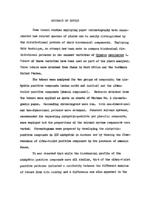- Collection:
- Atlanta University and Clark Atlanta University Theses and Dissertations
- Title:
- A comparative study of chromatographic patterns of rhizomes in several varieties of cyperus esculentus, 1964
- Creator:
- Addo, Peter E. A.
- Date of Original:
- 1964-08-01
- Subject:
- Degrees, Academic
Dissertations, Academic - Location:
- United States, Georgia, Fulton County, Atlanta, 33.749, -84.38798
- Medium:
- theses
- Type:
- Text
- Format:
- application/pdf
- Description:
- Some recent studies employing paper chromatography have demon-strated how related species of plants can be easily distinguished by the distributional pattern of their biochemical components. Employing this technique, an attempt has been made to compare biochemical dis-tributional patterns in two unnamed varieties of Cyperus ewculentus L. Tubers of these varieties have been used as part of the plant analyzed. These tubers were obtained from Ghana in West Africa and the Southern United States. The tubers were analyzed for two groups of compounds; the nin- hydrin positive compounds (amino acids and indoles) and the ultra�violet positive compounds (phenol compounds). Extracts obtained from the tubers were applied as spots on sheets of Whatman No. 1 chromato- grahic paper. Descending chromatograms were run. Both one-dimensional and two-dimensional patterns were obtained. Standard solvent systems, recommended for separating ninhydrin-positive and phenolic compounds, were employed but the proportions of the solvent system components were varied. Chromatograms were prepared by developing the ninhydrin- positive compounds in 2$% ninhydrin in acetone and by viewing the fluo�rescence of ultra-violet positive compounds in the presence of ammonia fumes. It was observed that while the biochemical profile of the ninhydrin positive compounds were all similar, that of the ultra-violet positive patterns indicated a similarity between the different samples of tubers from this country and a difference was also apparent in the profiles of the two varieties obtained from Ghana, The American material appeared to be the same as one of the Ghana varieties, the brown form. For the three collections of this variety analyzed, all exhibited similar profiles and similar values according to their ninhydrin-positive patterns. The other variety from Ghana, the black form exhibited a bio-chemical profile for the ultra-violet positive patterns that was different from both the American forms and the brown Ghana variety.
- External Identifiers:
- Metadata URL:
- http://hdl.handle.net/20.500.12322/cau.td:1964_addo_peter_ea
- Rights Holder:
- Clark Atlanta University
- Holding Institution:
- Atlanta University Center Robert W. Woodruff Library
- Rights:
-
